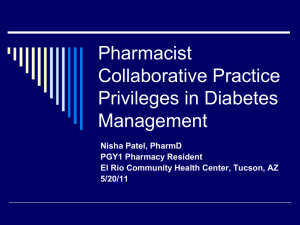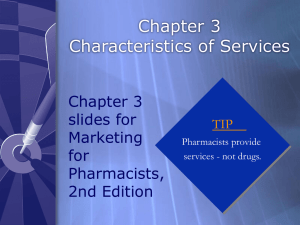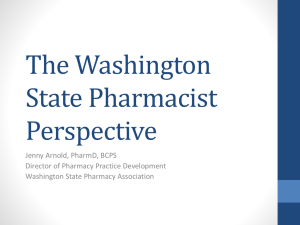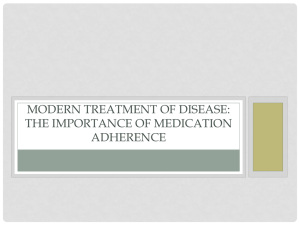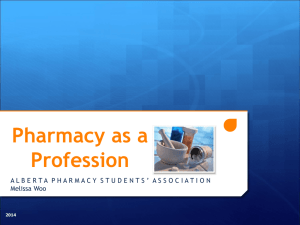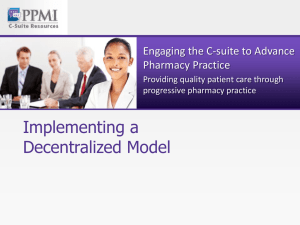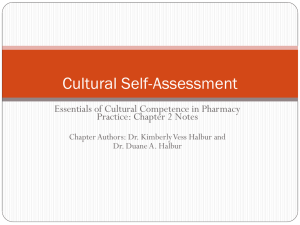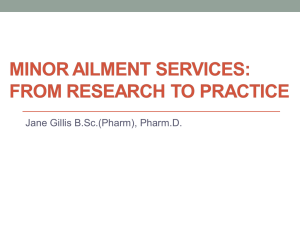CDTM Pharm Conference
advertisement
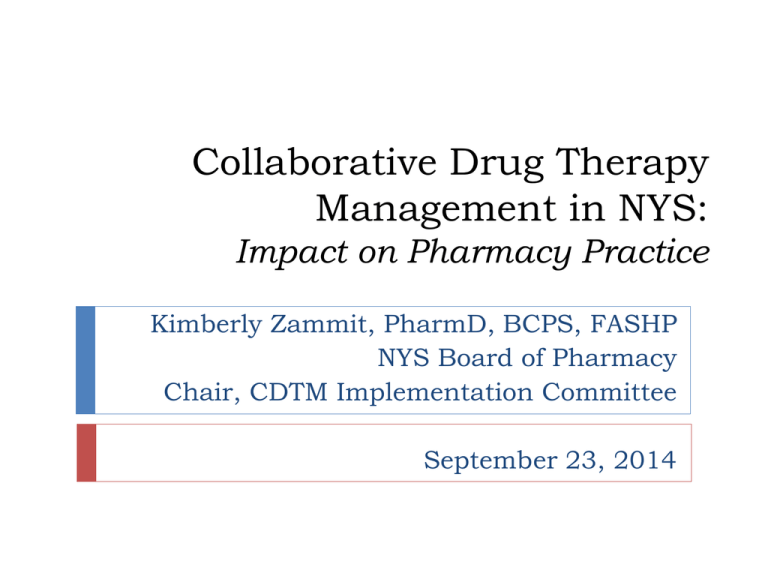
Collaborative Drug Therapy Management in NYS: Impact on Pharmacy Practice Kimberly Zammit, PharmD, BCPS, FASHP NYS Board of Pharmacy Chair, CDTM Implementation Committee September 23, 2014 Disclosures None to report Collaborative Drug Therapy Management ACCP Position Statement Agreement between one or more physicians and pharmacists Qualified pharmacists working within the context of a defined protocol are permitted to assume professional responsibility for: Performing patient assessments Ordering drug therapy-related laboratory tests Administering drugs Selecting, initiating, monitoring, continuing, and adjusting drug regimens. (aka prescribing) Pharmacotherapy 2003;23:1210-1225 CDTM in the U.S. 2012 Any setting Healthsystems Very limited in any setting http://www.cdc.gov/dhdsp/pubs/docs/Pharmacist_State_Law.PDF No CDTM Giberson S,Yoder S, Lee MP. Improving Patient and Health System Outcomes through Advanced Pharmacy Practice. A Report to the U.S. Surgeon General. Office of the Chief Pharmacist. U.S. Public Health Service. Dec 2011. http://www.usphs.gov/corpslinks/pharmacy/sc_comms_sg_report.aspx Report to the Surgeon General Objectives Obtain advocacy from the U.S. Surgeon General to: Acknowledge pharmacists that manage disease through medication use and deliver patient care services, as an accepted and successful model of health care delivery in the United States, based on evidence-based outcomes, performance-based data and the benefits to patients and other health system consumers. Recognize pharmacists, who manage disease and deliver many patient care services, as health care providers. One such action is advocate to amend the Social Security Act to include pharmacists among health care professionals classified as “health care providers.” Have pharmacists recognized by CMS as Non-Physician Practitioners in CMS documents, policies, and compensation tables commensurate with other providers, based on the level of care provided. Advance beyond discussion (and numerous demonstration projects) of the expanded roles of pharmacist-delivered patient care and move toward health system implementation Report to the Surgeon General Economic Benefit Benefit to Cost Ratio (US dollars) 1988 - 1995 1996 - 2000 2001 - 2005 Lowest 1.08 : 1 1.70 : 1 1.02 : 1 Highest 75.84 : 1 17.01 : 1 34.61 : 1 Median 4.09 : 1 4.68 : 1 4.81 : 1 Mean 16.70 : 1 5.54 : 1 7.98 : 1 Response from the Surgeon General Publically supports the role of pharmacists in collaborative practice Evidence and outcomes presented support the following: Health-care leadership and policy makers should explore ways to optimize the role of pharmacists through collaborative practice Collaborative practice will improve quality, contain costs and increase access to care Recognition of pharmacists as health care providers, clinicians and an essential part of the health care team is appropriate given the level of care they provide in many settings Compensation models reflective of the range of care provided are needed for sustainability http://www.usphs.gov/corpslinks/pharmacy/sc_comms_sg_report.aspx NYS CDTM Demonstration Project NYS CDTM Demonstration Project Report CDTM legislation passed in 2011required the development of a report: Review the extent to which CDTM was implemented in New York State Examine whether and the extent to which CDTM contributed to the improvement of quality of care for patients, reduced the risk of medication error, reduced unnecessary health care expenditures and was otherwise in the public interest. Make recommendations regarding the extension, alteration and/or expansion of these provisions Make any other recommendations related to the implementation of CDTM http://www.op.nysed.gov/news/cdtmreportmay2014final.pdf CDTM Report Writing Committee Board of Pharmacy Participant Representatives CDTM Implementation Committee Kimberly Zammit, PharmD, BCPS, FASHP Leigh Briscoe-Dwyer, PharmD, BCPS, FASHP Lawrence Mohkiber, RPh, MS Kimberly Leonard, RPh Kelly Rudd, PharmD, BCPS,CACP Bassett Healthcare Lisa Phillips, PharmD, CACP, BAAP Upstate Medical Center Mark Sinnett, PharmD, FASHP Montefiore Medical Center CDTM Demonstration Sites* Institution / Location Anthony Jordan Health Center / Rochester Bassett Healthcare Network / Cooperstown Bronx-Lebanon Hospital Center / Bronx Brooklyn Hospital Brooklyn Kingsbrook Jewish Medical Center / Brooklyn Memorial Sloan Kettering Cancer Center / New York Montefiore Medical Center / Bronx Rochester General Hospital / Rochester Roswell Park Cancer Institute / Buffalo United Health Services / Binghamton Upstate Medical Center / Syracuse * Programs submitting data Program Diabetes Anticoagulation Heart Failure Anticoagulation Asthma Diabetes Heart Failure HIV Anticoagulation Oncology Heart Failure Diabetes Oncology Anticoagulation Diabetes CDTM Demonstration Project Results Program Number of Patients Results Anticoagulation 841 TTR 71 – 84% Low rate of adverse effects Asthma 25 100% patients receiving therapy demonstrated to improve disease control 195 HbA1C Control 22 – 39% at goal 7 – 15 % decrease in 4 – 12 months 78 30 Day Hospitalization: 0 – 9 % ACEI / ARB: 88% Beta Blocker: 95% Diabetes Heart Failure HIV Oncology 864 visits Interventions optimized efficacy, safety and adherence 2304 interventions 12 patients Interventions optimized efficacy, safety and adherence Anticoagulation Anticoagulation Management Time in Target Range Measure Outcome at 5% increase in TTR Outcome at 10% increase in TTR Adverse Events Prevented 1114 2087 Number of Deaths Avoided 662 1233 Number of QualityAdjusted Life Years Gained 863 1606 $15.9 million $29.7 million Healthcare Dollars Saved (per 67,000 patients) Rose AJ, et al. Circ Cardiovasc Qual Outcomes. 2011; 4:416-424. Anticoagulation Management Number of Patients Age Range (years) Medicaid (N) Medicare (N) ADEs (per 100 patients) TTR Bassett Healthcare Brooklyn Hospital Kingsbrook Jewish United Health Usual Care 503 174 43 121 25-97 23-91 22-88 35-88 6 16 NR 25 393 60 19 95 4.97 3.45 2.32 0.82 19.5 84.6% 75.1% 71.2% Unable to report 57.4% Anticoagulation Participants Kelly Rudd, PharmD, BCPS,CACP Kingsbrook Jewish Medical Center Henry Cohen, MS, PharmD, FCCM, BCPP, CGP Bassett Healthcare Valery L. Chu, PharmD, BCACP, CACP United Health Services Hospitals Patient Centered Medical Home The Brooklyn Hospital Center Julie Anne Billedo, PharmD, BCACP Kingsbrook Jewish Medical Center Lindsey Wormuth, PharmD Rebecca Arcebido, PharmD, BCACP Patient Centered Medical Home The Brooklyn Hospital Center Robert DiGregorio, PharmD, BCACP The Brooklyn Hospital Center Diabetes Demographics Site Number of Patients Average Patient Age +/- SD (range) AJHC 60 60.4 ± 10.2 (38 – 83) Upstate 76 54 ± 11 (29-86) RGH 24 58.9 + 7.99 (52-70 ) Brooklyn 35 NR Target Hemoglobin A1C 70% 63% Percent Patients with HbA1c<8% 60% 54% 53% 50% 40% 31.80% 30% 25% 23.60% 20% 10% 0% Site 1 Baseline Site 1 12 months Site 2 Baseline Site 2 12 months Site 3 Baseline Site 3 4 months Change in Hemoglobin A1C Diabetes Participants Lisa Phillips, PharmD, CACP, BAAP St John Fisher College / WSOP Upstate Medical University Mary Jo Lakomski, BS Pharm, CDE, BCACP Upstate University Hospital Robert DiGregorio, PharmD, BCACP The Brooklyn Hospital Center Alex DeLucenay, PharmD, BCACP St John Fisher College, WSOP Rochester General Hospital Asim M. Abu-Baker, PharmD, CDE St. John Fisher College, WSOF Anthony Jordan Health Center Heart Failure Demographics Number (%) Mean SD 59 64.2 years 12.8 Gender: Male 32 (54%) n/a n/a Ejection fraction (EF) 57 (97%) 34.1% 11.6 48 (81%) 7165.5 pg/mL 11128 52 (88%) 1.7 mg/dL 1.4 Age N-terminal Pro-BNP Serum creatinine Re-Hospitalization 30 days Among 22 patients who were seen at the clinic within two weeks after discharge, the 30-day readmission rate was 9% (2 /22). 90 days 42 patients had at least one hospitalization in the prior 3 mos Five patients (12%) have not reached the three month time point 28 patients (67%) were not hospitalized In comparison to the previous 3 months: Three patients (7%) had one less hospitalization Two patients (4.5%) had one more hospitalization Four patients (9.5%) had one hospitalization prior to and one hospitalization after their clinic visits Pharmacist Interventions Addressed adherence Discontinued expired/inappropriate medications Switched patient to appropriate therapy Reconciled duplicate medications Corrected improper use of medications 0 10 20 30 40 50 60 Therapy Optimization Initiated ISDN/Hydralazine Initiated AA Uptitrated Diuretic Initiated Diuretic Uptitrated Beta blocker Uptitrated ACEI/ARB Initiated ACEI/ARB 0 5 10 15 20 25 30 35 40 Adherence Problems Resolved Does not understand directions Prefers not to take medication Forgets to take medication Drug is unavailable Patient cannot afford medication Heart Failure Participants Angela Cheng, PharmD, BCPS Montefiore Medical Center Danielle Garcia, PharmD, BCPS Montefiore Medical Group – Bronx East Charnicia E. Huggins, PharmD, MS Touro College of Pharmacy Bronx Lebanon Hospital HIV Pharmacist Interventions Intervention Category Optimization of therapy by indication N = 1408 (% of total) 532 (37.8) Unnecessary Drug Treatment 66 (4.6) Need for Additional Treatment 466 (33) Optimization of effectiveness 146 (10.4) Inadequate Dose Optimization of Safety 146(10.4) 165 (11.7) Adverse Reaction (prevented/identified) 112 (8) Excessive Dose 53 (3.8) Adherence 444 (31.5) Patient Satisfaction 4 3 2 3.74 3.64 3.62 1 0 The pharmacy team plays an Pharmacists at this clinic help A pharmacy team at this clinic important role in my care at me better understand how to has helped me to make sure I this clinic take medications and what to do not miss doses of my expect when taking them medications 1 = Strongly disagree 2 = Somewhat disagree 3 = Somewhat agree 4 = Strongly agree HIV Participant Agnes Cha, PharmD, AAHIVP, BCACP Arnold and Marie Schwartz School of Pharmacy and Health Sciences / Long Island University The Brooklyn Hospital Center Oncology Pharmacist Interventions Memorial Sloan Kettering Cancer Center Intervention Category Optimization of therapy by indication Discontinue Unnecessary Drug Treatment Discontinue Duplicative Therapy Initiate Therapy for Untreated Indication Optimization of effectiveness Incorrect Dose Inappropriate route Optimization of Safety Excessive Dose Dangerous Drug Interactions N = 2392 (% of total) 1235 (51.6) 482 (20.1) 37 (1.5) 716 (29.9) 694 (16.5) 627 (26.2) 67 (2.8) 363 (15.1) 119 (5) 244 (10.2) Provider Satisfaction MSKCC Overall Satisfied with CDTM program Reinforces physician/pharmacist relationship Optimizes Care Improves Efficiency 0 Strongly Agree 25 Agree 50 75 100 Pharmacist Interventions Roswell Park Cancer Institute Advised patient to continue therapy Patient medication counseling Added new therapeutic agent Changed medication dose Provider Satisfaction RPCI CDTM Services improves quality of care CDTM Services should be continued Clinical Pharmacy Specialist displayed adequate knowledge CDTM Services allows me more time to see patients Overall Satisfaction with CDTM Services 0 20 40 60 Very Satisfied/Strongly Agree/ Definitely Yes Satisfied/Agree/Probably Undecided Dissatified/Disagree/Probably not Very Dissatified/Strongly Disagree/Definitely Not 80 100 Patient Satisfaction RPCI Overall Rating of Pharmacist Services Comfortable talking to the pharmacist / asking medication questions Pharmacist was well informed and able to answer my questions Pharmacist follow up was appreciated Likelihood of scheduling another pharmacist visit 0 20 40 60 Very Satisfied/Strongly Agree/ Definitely Satisfied/Agree/Probably Undecided Dissatified/Disagree/Probably Not Very Dissatified/Strongly Disagree/Definitely Not 80 100 Oncology Participants Elizabeth Hansen PharmD, BCOP Roswell Park Cancer Institute Richard Tizon, PharmD, BCOP Memorial Sloan-Kettering Cancer Center Asthma Pharmacist Interventions Parameter Receiving a controller medication Rescue medication prescribed Asthma action plan reviewed and educated Medication directions reinforced (Patient did not initially demonstrate understanding) Frequency 25 (100%) 25 (100%) 25 (100%) 25 (100%) Optimization of Medication Therapy Additional medication needed to optimize therapy Unnecessary medication discontinued Potentially harmful medication discontinued 2 (8%) 1 (4%) 1 (4%) Asthma Participant Robert DiGregorio, PharmD, BCACP The Brooklyn Hospital Center Economic Outcomes CDTM Demonstration Results Economic Impact Estimated Annual Savings (millions) Diabetes Heart Failure Anticoagulation Asthma 0 200 400 600 800 1000 1200 1400 1600 Patient Satisfaction Survey CDTM Demonstration Results Patient Satisfaction Survey Care Improved with Pharmacist on Healthcare Team (n=124) Unsure, 3% No, 1% Yes, 96% CDTM Demonstration Results Patient Satisfaction Survey Overall quality of care Adequate time spent with patient Disease or Medication Understanding Pharmacist Relationship Excellent 0 50 Very Good Good 100 Patient Satisfaction Comments “Exceptional personnel” “Feeling better since being here” “I get to know more about my medication and its effectiveness” “My care is exceptional from my pharmacist” “Saved my life. Saved my sister’s life. I'm thankful for the patience and taking the time with me” “Pharmacists give you a better understanding of what your meds is supposed to do” “She is very patient and understanding with me. I enjoy her being the one helping me” Conclusions Collaborative management drug therapy services provided in this pilot program demonstrated: Ability of pharmacists to meet or exceed efficacy endpoints Reduced risk of adverse reactions and hospitalizations Optimized medication management Reduced expenditures to the health care system High rates of satisfaction by both patients and physicians Recommendations CDTM should be expanded to allow all qualified pharmacists to participate Collaborative Drug Therapy Management in NYS: Proposed Legislation Leigh Briscoe-Dwyer, PharmD, BCPS, FASHP NYS Board of Pharmacy CDTM Implementation Committee September 23, 2014 Proposed Legislation Would add additional practitioners who may enter into CDTM agreements with pharmacists NPs PAs Adds the term “Facility” Proposed Legislation CDTM can take place in any facility or practice Facility is defined as Hospital Diagnostic Center Treatment Center Hospital based outpatient department Residential Health Care Facility Nursing Home Practice shall mean a place or situation in which physicians, physician assistants and nurse practitioners, either alone or in group practices, provide diagnostic and treatment care for patients Proposed Legislation Includes verbiage on “prescribing” in order to adjust or manage a drug regimen of a patient, pursuant to a patient specific order or non-patient specific protocol. Evaluating and ordering disease state and laboratory tests related to drug therapy management of the disease or disease states specified within a protocol Performing routine patient monitoring functions as may be necessary (Vitals) No Informed Consent No Sunset Pharmacist Credentials Must have a current unrestricted license in NY Satisfy any two (2) of the following: Certification in a relevant area of practice from an organization recognized by ACPE or another entity recognized by the State Education Department Postgraduate residency through an accredited postgraduate institute At least 50% of the experience includes the provision of direct patient care with interdisciplinary teams Have provided clinical services to patients for at least 1 year Pharmacists who meet the experience requirements will be certified by State Education Department to enter into CDTM agreements Pharmacist Credentials: Experience Provision of clinical services to patients for at least one year Under a collaborative practice agreement with a physician or other recognized provider, OR Has documented experience in the provision of clinical services to patients for at least one year and deemed acceptable to the department upon recommendation of the board of pharmacy A licensed pharmacist may engage in CDTM under the supervision of a CDTM pharmacist in order to gain experience necessary to qualify to participate Why credentialing in pharmacy? Increasing complexity in healthcare Technology advancement Expectation of pharmacist involvement in patient care teams Participation / management of advanced practice activities Demand for safe, effective and high quality care IOM report – licensure/CE inadequate Consumer group/public demand Scrutiny by hospital quality and risk departments Credentialing Credentialing “Ensures”: Documented evidence of professional qualifications Demonstration that they possess the knowledge to manage certain disease states Examples: Academic degrees State licensure Residency diplomas Certifications eg. BCPS, BCOP, BCPP, BCNSP, BCNP, BCACP, CDE, AE-C, CACP Certificate Programs (ASHP, ACCP, NYSCHP) Board Certification Pharmacist-only Board of Pharmaceutical Specialties (BPS) Commission for Certification in Geriatric Pharmacy Ambulatory, Cardiology (AQ), ID (AQ), Nuclear, Nutrition Support , Oncology, Pharmacotherapy, Psychiatry BPS is by the National Commission for Certifying Agencies Pediatric and Critical Care Fall 2015 Certified Geriatric Pharmacist Multidisciplinary Various certification bodies Anticoagulation, Asthma, BLS/ACLS, Clinical Pharmacology, Diabetes (education and management), Health Information Technology, HIV, Lipids, Pain (education and management), Poison information, Toxicology http://www.pharmacycredentialing.org/Files/CertificationPrograms.pdf http://www.pharmacycredentialing.org/Files/CertificationPrograms.pdf Spectrum of Clinical Practitioners Narrow Broad Breadth of patient / practice focus Focused Practitioner Wide variety of patients and diseases; minor ailments to more complex conditions Wide variety of diseases in a unique setting or population, or a narrow disease focus Advanced Generalist Practitioner Advanced Focused Practitioner Wide variety of patients and diseases; complex healthcare issues Focused patient populations; medically complex patients, therapies, and/or technology Level of knowledge, skills and experience Generalist Practitioner Entry level Advanced http://www.pharmacycredentialing.org/Contemporary_Pharmacy_Practice.pdf Why Residency Training? Allows training as a licensed practitioner under the supervision of an experienced preceptor Develops skills specific to the management of drug therapy in a systematic fashion Supported by ACCP and ASHP Direct patient care and practice management 2020 Goal: All pharmacists that provide direct patient care will have completed a PGY1 residency Expansion of residency programs will be necessary to achieve this goal Residency equivalency process / practice portfolio Pharmacotherapy 2009;29(12):399e–407e PGY 1 Residency Training Supply vs. Demand Current Legislation Status
